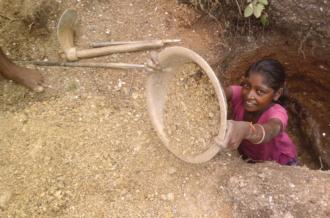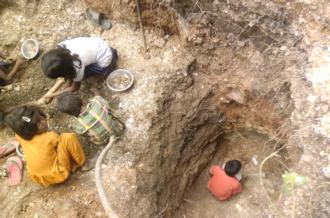Ugly truth behind global beauty industry
Top cosmetic brands rely on Indian children working in illegal mines to extract mica, key ingredient in makeup products.

Koderma, India – Children toiling illegally in Indian mines are producing a key ingredient used in the products of some of the global cosmetics industry’s most prominent names.
A report by campaign group DanWatch said child labour is being used in the eastern states of Jharkhand and Bihar to extract mica, which is then added to the make-up produced by at least 12 multinational companies.
Keep reading
list of 4 items‘Children of the Ganges’ — The boatmen of India’s Varanasi
US senators call on Biden to sanction Sudan’s RSF over human rights abuses
Israeli attack kills 10, mostly children, in Gaza’s Rafah
At least 5,000 children may be producing mica – used to add glitter to natural cosmetics – which is bought by intermediaries and then exported to high-profile international customers such as L’Oreal and Estee Lauder.
“In our research we found illegal mica mining often involves child labour, which is a significant problem in India,” Louise Voller of DanWatch told Al Jazeera.
“This report confirms that most companies do not give the consumers a clear picture of their supply chain.”
In our research we found illegal mica mining often involves child labour, which is a significant problem in India. This report confirms that most companies do not give the consumers a clear picture of their supply chain.
Deadly work
The abandoned mica mines start shimmering under the rising sun in Koderma, Jharkhand, as a group of sleepy children trudges towards the Charki mine holding their tools.
Five-year-old Ajay Das hurriedly slips into a narrow hole and starts his day. His tiny hands can barely balance the hammer, but he still hits the glistening wall accurately.
Ajay works six days a week and after labouring for seven to eight hours each day in hazardous conditions,he manages to earn a paltry 20 rupees ($0.33) – barely enough to kill his hunger pangs.
“The mines were closed two decades ago. Since then, poor people from neighbouring areas have been involved in scrap mining,” Ramlakhan Paswan, a schoolteacher working near the Charki mines, told Al Jazeera.
“This leads to mishaps every now and then. At times, children working with their parents often get trapped and die when the roof or the mine wall collapse.”
Miner Karu Das, 25, lost his wife to an accident in Charki mine five-years ago.
“She had come to collect mica scraps but got trapped in the mine,” Karu said. “By the time we dug her out she was dead.”
But Karu continues to risk his own life – and the lives of his children – as they have no other source of income. “Legal or illegal, it guarantees two square meals a day.”
|
|
Soaring demand
A boom in mica – a key ingredient in products such as facepacks, mascara, eyeliner, lipstick, and nail polish – is being fuelled by soaring demand for natural cosmetics, as artificial makeup made of synthetic chemicals have been linked to illness, including cancer.
 |
| About 5,000 children are involved in scrap mining, according to Suresh Kumar Jain, owner of a Koderma-based mica exporting company [Sanjay Pandey/Al Jazeera] |
According to the Indian Bureau of Mines, the country officially produces about 15,000 tonnes of crude and scrap mica a year, but surprisingly, in 2011-12 India exported more than 130,000 tonnes – more than eight times the official figure.
About half of India’s export was destined for China, from where it was then routed to several European and US cosmetic giants.
It has been two decades since most mica mines were closed on environmental grounds, but the closures prompted many people to resort to illegal mining, pushing children into this hazardous work.
According to DanWatch, most of India’s exports of high-quality mica flakes comes from illegal mines – and are produced by child miners such as Ajay.
Jharkhand lost about $4bn to illegal mining in 2012-13, according to a recent federal government report.
5,000 children
Suresh Kumar Jain, owner of Koderma-based mica exporter Jain Brothers, said: “The mica industry used to employ 20,000 people until 1993. But now it merely employs 1,000 people legally. But around 5,000 children are involved in scrap mining. The government should allow these poor villagers to do mining and do it in safety after taking the necessary precautions.”
The report on the use of child labour in the cosmetics industry by DanWatch – an NGO that campaigns against the exploitation of workers – examined 16 companies behind 20 brands. Twelve cannot or will not disclose where they source the mica they use.
German company Merck KGaA, which supplies mica to cosmetic brands around the world such as L’Oreal, admitted to sourcing the raw material from exporters in Jharkhand and Bihar. However, the company said that the minerals were extracted from legal mines.
But research carried out by DanWatch suggests the contrary, pointing out that it was impossible to differentiate between mica extracted from legal and illegal mines. Local exporters have maintained that the number of legal mines has decreased drastically since the 90s.
The intermediaries, however, will not name their foreign clients.
“We cannot reveal the name of our clients. It is a business secret. All I can tell you is that we process the raw material and ship it to our clients abroad,” said Mohan Modi, an intermediary, who even refused to disclose the name of his company.
In an email statement to Al Jazeera, Merck’s manager of media relations Gerhard Lerch, said: “The Merck Social Charter explicitly bans child labour. We demand that our suppliers act accordingly, stipulating in our contracts with them that they do not employ children … Merck has implemented all necessary steps to ensure compliant sourcing and to ensure that no children are involved in the processing of the pigment.”
Merck said it has reduced dependence on Indian-sourced mica, but it will continue to receive it from mines in Jharkhand. In terms of efforts to combat child labour in mines, Lerch said the company has a tracking system for the mica, and it constantly communicates with the Jharkhand government.
|
|
Blind eye
United Nations conventions make it illegal for children under 14 years old to work in mining, which the International Labour Organisation said is the worst form of child exploitation.
Yet the fact that child labour is used to mine mica in India appears to be well known – even though the government turns a blind eye to the problem.
When Al Jazeera asked India’s mines secretary Anup K Pujari about illegal mica mining in Jharkhand, he replied: “What am I supposed to say? Well, the government doesn’t recognise any illegal activity there.”
 |
| Jharkhand lost about $4bn to illegal mining in 2012-13 [Sanjay Pandey/Al Jazeera] |
Mica use in cosmetics has also been linked to child labour in the past. In 2009, Merck KGaA was accused of using children to mine mica in India.
In a face-saving gesture, the pharmaceutical giant opened schools in partnership with NGO Bachpan Bachao Andolan (BBA), an organisation that has helped create “child-friendly villages” in Jharkhand, where children do not work.
However, BBA’s founder Kailash Satyarthi has called Merck’s efforts “window dressing”.
“They don’t have a sustainable programme,” he said. “They started the schools with much fanfare, but we have observed that none of the schools and health centres are functioning properly now.
“The government does not want to stop illegal mining and cares little about the welfare of the children.”
|
|